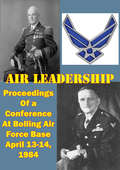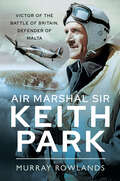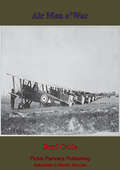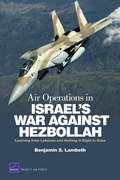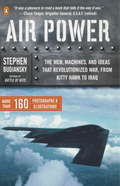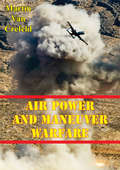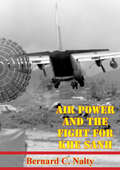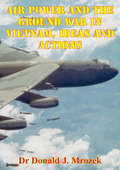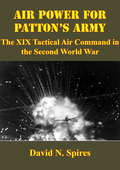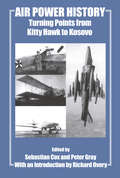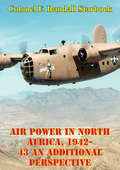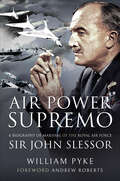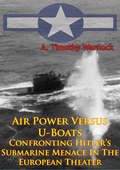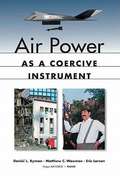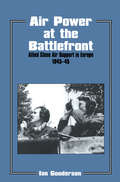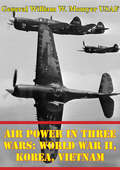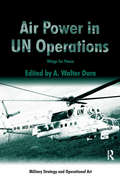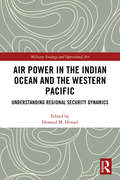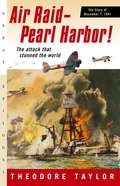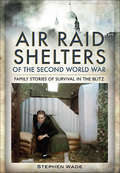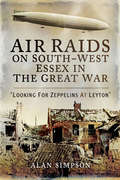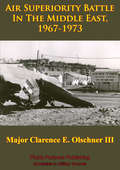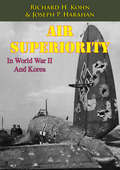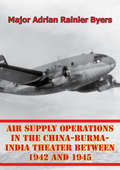- Table View
- List View
Air Leadership - Proceedings of a Conference at Bolling Air Force Base April 13-14, 1984: Proceedings Of A Conference At Bolling Air Force Base, April 13-14 1984
by Wayne ThompsonMore than 200 airmen and historians met in Washington, D.C., on April 13 and 14, 1984, to discuss the men who have led American air forces. The first century of air power is drawing to a close and though some retired air leaders joined in the discussion, many have passed from the scene. What kind of men were they? What kind of leaders were they? What can we learn from their experience?The conference approached broad questions of leadership by taking a close look at two air leaders, Rear Adm. William A. Moffett (1869-1933) and Gen. Carl A. Spaatz (1891-1974). While Chief of the Navy's Bureau of Aeronautics during the 1920s, Moffett did as much as anyone to nurture air power within the Navy. Spaatz, on the other hand, helped to lead the increasingly autonomous Army Air Forces during World War II and became the first Chief of Staff of the independent Air Force when it separated from the Army in 1947.Despite the major roles played by Moffett and Spaatz in the development of American air power, there has been little biographical work on them until recently. A decade ago Alfred Goldberg, chief historian in the Office of the Secretary of Defense, contributed an essay on Spaatz to Field Marshal Sir Michael Carver's The War Lords. Richard G. Davis, an Air Force historian, has just completed a dissertation on Spaatz's service in World War II. Meanwhile the Air Force Historical Foundation has sponsored a biography of Spaatz by Lt. Col. David R. Mets, USAF, Retired, and the first fruit of his effort is one of two essays on Spaatz published here; the other is by Maj. Gen. I. B. Holley, Jr., USAFR, Retired, who has drawn upon his many years as a professor of military history and biographer.
Air Marshal Sir Keith Park: Victor of the Battle of Britain, Defender of Malta
by Murray RowlandsA long-overdue biography of the dedicated commander from New Zealand who helped ward off the Luftwaffe and save Britain from a Nazi invasion.The Battle of Britain from July to September 1940 is one of the finest moments in Britain’s history. While credit rightly goes to “The Few,” victory could never have happened without the inspirational command and leadership of New Zealander Keith Park.He and Air Chief Marshal Sir Hugh Dowding ensured that Fighter Command was prepared for the Nazi onslaught. Promoted to Air Vice Marshal, Park took over No 11 Group, responsible for the defense of London and South East England in April 1940. A shrewd tactician and hands-on commander, Park carefully husbanded his limited resources and famously wore down Goering’s Luftwaffe, thus forcing Hitler to abandon his invasion plans.Shamefully, Dowding and Park were dismissed from their commands in the aftermath of victory due to internal RAF politics. Fortunately, Park’s career was far from over and his management of the defense of Malta made a significant contribution to victory in the Mediterranean. This balanced and well overdue account aims to ensure that Air Chief Marshal Sir Keith Park receives the credit for this victory that he so richly deserves.Includes photographs
Air Men o'War.
by Boyd CableThe war above the battle lines of the First World War is brought to life in these tales of the cavalry of the skies. However, by and large, the knights of the air were not much given to self-publicity that their exploits and effectiveness entitled them to. Writing under a pseudonym, Boyd Cable, who spent a year at the front with them, wrote of the feats of his flying companions. From flying patrols through 'archie' fire, bombing raids, and interceptions of enemy planes, the author captures the fascinating war within a war in the skies above.Author -- Cable, Boyd.Text taken, whole and complete, from the edition published in New York, E.P. Dutton & Company, 1919.Original Page Count - x and 246 pages.
Air Operations in Israel's War Against Hezbollah
by Benjamin S. LambethExamines the inconclusive results of the Israeli Defense Forces' operation in Lebanon after Hezbollah abducted two Israeli soldiers in 2006, which many believe represents a "failure of air power." The author demonstrates that this is an oversimplification of a more complex reality and contrasts the operation with Israel's counteroffensive against Hamas in the Gaza Strip in December 2008 and January 2009.
Air Power
by Stephen BudianskyNo single human invention has transformed war more than the airplane—not even the atomic bomb. Even before the Wright Brothers’ first flight, predictions abounded of the devastating and terrible consequences this new invention would have as an engine of war. Soaring over the battlefield, the airplane became an unstoppable force that left no spot on earth safe from attack. Drawing on combat memoirs, letters, diaries, archival records, museum collections, and eyewitness accounts by the men who fought—and the men who developed the breakthrough inventions and concepts—acclaimed author Stephen Budiansky weaves a vivid and dramatic account of the airplane’s revolutionary transformation of modern warfare. On the web: http://www. budiansky. com/ .
Air Power And Maneuver Warfare
by Professor Martin Van CrefeldAn essential part of the Air War College, Maxwell Air Force Base (AFB), Alabama, curriculum consists of the study of military history and specific campaigns. Distinguished military scholars often visit the college to discuss and explore issues with the faculty. Martin van Creveld was one of those distinguished scholars. He had previously been commissioned by the Air Staff to investigate the effects of the US Army's move toward a more maneuver-oriented kind of warfare and the effect that move will have on the US Air Force role on the battlefield. The Air Staff was concerned about a host of issues: logistic support for a highly mobile force; friendly force confusion on huge, rapidly changing battlefields; close air support with or without air base support; and a host of other issues. The bottom line for the Air Force concerned several issues of great impact. First, Must air combat change because land combat is changing? and, Is the decisiveness of air power increasing geometrically to the point where the twenty-first century will find it is as decisive as ground power was in the twentieth century?Our guest historian agrees that sophisticated, highly technical air and space developments may have made air power dominant on the conventional battlefield. The great exception, however, lies in the trend away from conventional to unconventional conflict. To Professor van Creveld, nation-states have lost the monopoly on the legitimate use of violence. To prepare for a conventional scenario is to prepare for the last war, not the next one. The possibility of more "Lebanons" is much higher than the likelihood of future "Iraqs."
Air Power And The Fight For Khe Sanh [Illustrated Edition]
by Bernard C. NaltyIncludes 60 photos and 7 maps and chartsThe 1968 fight for Khe Sanh pitted some 6,000 U.S. Marines and South Vietnamese Rangers against an enemy force roughly three times as large. For more than 70 days North Vietnamese troops maintained pressure on Khe Sanh's defenders, who had dug in around the base's airstrip. The original purpose for deploying the Marines and South Vietnamese into the northwest corner of South Vietnam was to block Communist troop movements along Highway 9 toward Quang Tri City and the heavily populated coastal areas. When U.S. intelligence detected large enemy forces assembling near Khe Sanh, the senior American commander in Vietnam, Gen. William C. Westmoreland, ordered the Marines to hold the base.During the siege that followed, U.S. strike aircraft rained nearly 100,000 tons of munitions down upon the North Vietnamese while other planes--primarily U.S. Air Force transports--flew in essential supplies of food, ammunition, and other necessities to Khe Sanh's defenders. The Leathernecks also used their own aircraft to provision Marine outposts which denied the enemy the high ground overlooking the base. Other military elements participating in the battle included U.S. Army artillerymen dug in east of Khe Sanh, who fired deadly concentrations against the besieging forces. Marine howitzers and mortars added to the heavy U.S. fire, while Army engineers joined Navy Seabees in helping prepare airstrips which supported the allied defense effort. Finally, the relief of Khe Sanh--though spearheaded by Army troops--also involved American Marines and soldiers of the Army of the Republic of Vietnam.
Air Power And The Ground War In Vietnam, Ideas And Actions: Ideas And Actions
by Dr Donald J. MrozekUltimately, this study is about a smaller Vietnam War than that which is commonly recalled. It focuses on expectations concerning the impact of air power on the ground war and on some of its actual effects, but it avoids major treatment of some of the most dramatic air actions of the war, such as the bombing of Hanoi. To many who fought the war and believe it ought to have been conducted on a still larger scale or with fewer restraints, this study may seem almost perverse, emphasizing as it does the utility of air power in conducting the conflict as a ground war and without total exploitation of our most awe-inspiring technology.Although the chapters in this study are intended to form a coherent and unified argument, each also offers discrete messages. The chapters are not meant to be definitive. They do not exhaust available documentary material, and they often rely heavily on published accounts. Nor do they provide a complete chronological picture of the uses of air power, even with respect to the ground war. Nor is coverage of areas in which air power was employed--South Vietnam, Laos, Cambodia, and North Vietnam--evenly distributed nor necessarily proportionate to the effort expended in each place during the war. Lastly, some may find one or another form of air power either slightly or insufficiently treated. Such criticisms are beside the point, for the objectives of this study are to explore a comparatively neglected theme--the impact of air power on the ground--and to encourage further utilization of lessons drawn from the Vietnam experience.
Air Power For Patton’s Army: The XIX Tactical Air Command In The Second World War [Illustrated Edition]
by David N. SpiresIllustrated with 3 charts, 28 maps and 88 photos.This insightful work by David N. Spires holds many lessons in tactical air-ground operations. Despite peacetime rivalries in the drafting of service doctrine, in World War II the immense pressures of wartime drove army and air commanders to cooperate in the effective prosecution of battlefield operations. In northwest Europe during the war, the combination of the U.S. Third Army commanded by Lt. Gen. George S. Patton and the XIX Tactical Air Command led by Brig. Gen. Otto P. Weyland proved to be the most effective allied air-ground team of World War II.The great success of Patton's drive across France, ultimately crossing the Rhine, and then racing across southern Germany, owed a great deal to Weyland's airmen of the XIX Tactical Air Command. This deft cooperation paved the way for allied victory in Western Europe and today remains a classic example of air-ground effectiveness. It forever highlighted the importance of air-ground commanders working closely together on the battlefield.
Air Power History: Turning Points from Kitty Hawk to Kosovo (Studies in Air Power #Vol. 13)
by Peter Gray Richard Overy Sebastian Coxhe 20th century saw air power transformed from novelists' fantasy into stark reality. From string and canvas to precision weaponry and stealth, air power has progressed to become not only the weapon of first political choice, but often the only conceivable option. This rapid development has given rise to considerable debate and controversy with those holding entrenched views rarely slow to shout their case. Many myths have grown over the period, ranging from the once much vaunted ability of air power to win wars alone through to its impact as a coercive tool.This volume examines the theory and practice of air power from its earliest inception. The contributors have been drawn from academia and the military and represent some of the world's leading proponents on the subject. All significant eras on air power employment are examined: some are evidently turning points, while others represent continuous development. Perhaps more importantly, the book highlights the areas that could be considered to be significant, and invites the reader to enter the debate as to whether it constitutes a continuum, a turning point, or indeed a revolution.
Air Power In North Africa, 1942-43: An Additional Perspective
by Colonel F. Randall StarbuckThe hastily mounted invasion of French Northwest Africa in November of 1942 was a gamble. It exposed American inexperience. That inexperience went from Roosevelt on down to the soldier in the foxhole. Half-trained men were pitted against Vichy France and didn't know whether to expect open arms or open fire. Later, those same inexperienced men would meet Rommel at the Kasserine Pass. This naivete was exhibited by both men and leaders. Torch was Eisenhower's first major operation--a gigantic airlift and sealift preceded by months of intrigue. The outcome of the campaign settled several air power issues and revealed many lessons. The battles fought by the United States forces during the North African Campaign of 1942 and 1943, particularly the Battle for the Kasserine Pass in February 1943, were a breaking and testing ground for much of the employment of those forces during the remainder of the Second World War. Three air power key lessons were learned on the North African battlefield. First was the need for coordination between air and ground forces. Second was the folly of sending untrained airmen into combat. Third was the importance of tactical air targeting by ground force commanders.
Air Power Supremo: A Biography of Marshal of the Royal Air Force Sir John Slessor
by William PykeSir John Slessor was one of the twentieth century’s most distinguished wartime commanders and incisive military thinkers, and William Pyke’s comprehensive new biography reveals how he earned this remarkable reputation. Slessor, a polio victim who always walked with a stick, became a First World War pilot in the Sudan and on the Western Front and a squadron and wing commander in India between the wars. When aerial warfare was still a new concept, he was one of the first to develop practical tactics and strategies in its application. In the Second World War, as the Commander-in-Chief of Coastal Command during the Battle of the Atlantic and the RAF in the Mediterranean during the Italian and Balkan campaigns, he made a remarkable contribution to the success of Allied air power. Then, after the war, as a senior commander he established himself as one of the foremost experts on strategic bombing and nuclear deterrence. That is why this insightful biography of a great British airman and his achievements is so timely and important as we enter a new era of strategic doubts and deterrence at the beginning of the twenty-first century. William Pyke follows each stage of Slessor’s brilliant career as a pilot and commander in vivid detail. In particular he concentrates on Slessor’s writings, from his treatise on the application of air power in support of land armies to his thinking on nuclear deterrence and Western strategy.
Air Power Versus U-Boats - Confronting Hitler’s Submarine Menace In The European Theater [Illustrated Edition]
by A. Timothy WarnockIncludes over 14 photos and mapsMore than fifty years after World War II, America's major air power contribution to the war in Europe-in efforts such as Big Week, Regensburg, and Patton's dash across Europe-live on in the memories of airmen and students of air power. Never before had air forces performed so many roles in so many different types of operations. Air power proved to be extremely flexible: wartime missions included maintaining air superiority, controlling the air space over the battlefield; strategic bombardment, destroying the enemy's industrial and logistical network; air-ground support, attacking targets on the battlefield; and military airlift, delivering war materiel to distant bases.Perhaps one of the least known but significant roles of the Army Air Forces (AAF) was in antisubmarine warfare, particularly in the European-African-Middle Eastern theater. From the coasts of Greenland, Europe, and Africa to the mid-Atlantic, AAF aircraft hunted German U-boats that sank thousands of British and American transport ships early in the war. These missions supplemented the efforts of the Royal Navy, the Royal Air Force Coastal Command, and the U.S. Navy, and helped those sea forces to wrest control of the sea lanes from German submarines.
Air Power as a Coercive Instrument
by Ian O. Lesser Keith Crane Seth G. Jones Rollie Lal John G. Mcginn Daniel BymanCoercion--the use of threatened force to induce an adversary to change its behavior--is a critical function of the U.S. military. U.S. forces have recently fought in the Balkans, the Persian Gulf, and the Horn of Africa to compel recalcitrant regimes and warlords to stop repression, abandon weapons programs, permit humanitarian relief, and otherwise modify their actions. Yet despite its overwhelming military might, the United States often fails to coerce successfully. This report examines the phenomenon of coercion and how air power can contribute to its success. Three factors increase the likelihood of successful coercion: (1) the coercer's ability to raise the costs it imposes while denying the adversary the chance to respond (escalation dominance); (2) an ability to block an adversary's military strategy for victory; and (3) an ability to magnify third-party threats, such as internal instability or the danger posed by another enemy. Domestic political concerns (such as casualty sensitivity) and coalition dynamics often constrain coercive operations and impair the achievement of these conditions. Air power can deliver potent and credible threats that foster the above factors while neutralizing adversary counter-coercive moves. When the favorable factors are absent, however, air power--or any other military instrument--will probably fail to coerce. Policymakers' use of coercive air power under inauspicious conditions diminishes the chances of using it elsewhere when the prospects of success would be greater.
Air Power at the Battlefront: Allied Close Air Support in Europe 1943-45 (Studies in Air Power #Vol. 6)
by Dr Ian GoodersonIan Gooderson presents a study of close air support in World War II, with the analysis focusing on the use of tactical air power by British and American forces during the campaigns in Italy and northwestern Europe between 1943 and 1945.
Air Power in Three Wars: World War II, Korea, Vietnam [Illustrated Edition]
by General William W. Momyer USAF[Includes over 130 illustrations and maps]This insightful work documents the thoughts and perspectives of a general with 35 years of history with the U.S. Air Force - General William W. Momyer. The manuscript discusses his years as a senior commander of the Air Force - strategy, command and control counter air operations, interdiction, and close air support. His perspectives cover World War II, the Korean War and the Vietnam War.
Air Power in UN Operations: Wings for Peace (Military Strategy and Operational Art)
by A. Walter DornAir power for warfighting is a story that's been told many times. Air power for peacekeeping and UN enforcement is a story that desperately needs to be told. For the first-time, this volume covers the fascinating range of aerial peace functions. In rich detail it describes: aircraft transporting vital supplies to UN peacekeepers and massive amounts of humanitarian aid to war-affected populations; aircraft serving as the 'eyes in sky' to keep watch for the world organization; and combat aircraft enforcing the peace. Rich poignant case studies illuminate the past and present use of UN air power, pointing the way for the future. This book impressively fills the large gap in the current literature on peace operations, on the United Nations and on air power generally.
Air Power in the Falklands Conflict: An Operational Level Insight into Air Warfare in the South Atlantic
by John ShieldsFrom the television footage shown in all its stark reality and the daily coverage and subsequent memoirs, the impression delivered from the air battles in the Falklands Conflict was that of heroic Argentine pilots who relentlessly pressed home their attacks against the British. While, by contrast, there is a counter-narrative that portrayed the Sea Harrier force as being utterly dominant over its Argentine enemies. But what was the reality of the air war over the Falkland Islands? While books on the air operations have published since that time, they have, in the main, been personal accounts, re-told by those who were there, fighting at a tactical level, or back in their nation’s capital running the strategic implications of the outcome. But a detailed analysis of the operational level of the air war has not been undertaken – until now. At the same time, some analysts have inferred that this Cold War sideshow offers little insight into lessons for the operating environment of future conflicts. As the author demonstrates in this book, there are lessons from 1982 that do have important and continued relevance today. Using recently released primary source material, the author, a serving RAF officer who spent two-and-a-half years in the Falklands as an air defence navigator, has taken an impartial look at the air campaign at the operational level. This has enabled him to develop a considered view of what should have occurred, comparing it with what actually happened. In so doing, John Shields has produced a comprehensive account of the air campaign that has demolished many of the enduring myths. This is the story of not why, but how the air war was fought over the skies of the South Atlantic.
Air Power in the Indian Ocean and the Western Pacific: Understanding Regional Security Dynamics (Military Strategy and Operational Art)
by Howard M. HenselThis book examines the security dynamics of the Indian Ocean and the Western Pacific, concentrating upon an analysis and evaluation of the air power capabilities of the various powers active in the two regions. The volume is designed to help improve understanding of the heritage and contemporary challenges confronting the global community in the Indian Ocean and the Western Pacific, as well as to illuminate the policies of the various powers involved in the affairs of these regions, and the military capabilities that are available in support of those policies. The 16 individual chapters examine both the traditional and the non-traditional threats that confront the various Indian Ocean and Western Pacific powers, and assess the roles played by land-based and naval, fixed-wing and rotary-wing, manned and unmanned aircraft, as well as by offensively and defensively capable ballistic and cruise missiles in addressing these challenges. In doing so, the various chapters analyze and evaluate the air power doctrine, capabilities, deployment patterns, and missions of the respective states. In addition, they assess the future issues, challenges, and responses involving air power as it, acting in concert with other military instruments, seeks to contribute to securing and promoting the interests of the state. This book will be of much interest to students of air power, strategic studies, Asian and Middle Eastern politics, and International Relations.
Air Raid -- Pearl Harbor!: The Story of December 7, 1941
by Theodore TaylorIt examines from both the American and Japanese points of view the political and military events leading up to the attack on Pearl Harbor.
Air Raid Shelters of the Second World War: Family Stories of Survival in the Blitz
by Stephen WadeThis book features the design, creation and use of air raid shelters, including interviews with people who used them during the Second World War. The different types of bunkers/air raid shelters (both public and in peoples gardens) are covered and the strength and weakness of their designs discussed, using original designs and primary material. The nostalgia/social history of the book covers peoples experiences of staying in the air raid shelters. These are divided into topics, including getting to the shelters (how they reacted to the sirens or whether they just moved into the shelters, especially those in gardens, long-term), facilities, health issues, morale and safety, both real and perceived. In recent years, air raid shelters have been converted into different uses, including homes, and the book will finish with a brief chapter concerning the future and preservation of these once vital buildings.
Air Raids on South-West Essex in the Great War: Looking for Zeppelins at Leyton
by Alan SimpsonA quarter of a century before the Blitz of 1940, the inhabitants of south-west Essex were terrorized by an earlier aerial menace. Over the course of four years, German Zeppelins, Gothas and Giants flew above their homes, unleashing hundreds of highly explosive and incendiary bombs on London. During three of these raids, bombs were dropped on Leyton and many others landed elsewhere in south-west Essex. These early air raids are now largely forgotten in local memory, but for the inhabitants of the time the attacks were unprecedented, unexpected and lethal.In the years since the Great War a great deal of literature has been published on London's first air raids and about the defence network that evolved around the metropolis, but what happened in the capital's eastern suburbs and the nearby Essex countryside has received less coverage. This meticulously researched and insightful book attempts to put that right, looking at the area which, in 1914, was part of south-west Essex, but now comprises the London boroughs of Waltham Forest, Redbridge, Havering, Newham, and Barking and Dagenham.Focussing in particular on Leyton and Ilford, this is the first book to ever examine what happened before and after the raiders reached and bombarded the capital. The author has included a wide range of contemporary letters, diaries and newspaper reports from local sources, plus several previously unseen photographs. To set the story in its wider context, the book also contains a wealth of information about the defence of the London area generally and vivid reports from combatants on both sides.
Air Superiority Battle In The Middle East, 1967-1973
by Major Clarence E. Olschner IIIThis paper is an historical study of the strategy, tactics, and weapons employed by Israel, Egypt, and Syria in the battle for air superiority from 1967 through 1973. The study is developed chronologically beginning with the 1967 War, through the War of Attrition, and ending with the cease-fire in the 1973 War. It has been compiled from an extensive review of unclassified, primarily secondary, unofficial sources. The paper concludes that, in a mid-intensity war with modern air forces and air defense forces: 1) The achievement of strategic, tactical, and/or technological surprise can significantly influence the battle for air superiority, 2) Missiles have demonstrated the capability to significantly influence the air superiority battle in surface-to-air, air-to-air, and air-to-ground operations, 3) Air superiority can be achieved over the modern battlefield only by defeating both surface-to-air and air-to-air capabilities of the enemy, 4) The achievement of air superiority over the battle area requires the combined efforts of air and land forces of which long range artillery may be the most effective weapon for the suppression of surface-based air defenses.
Air Superiority In World War II And Korea [Illustrated Edition]
by Joseph P. Harahan Richard H. KohnIncludes over 20 illustrations.In November 1981, Lt. Gen. Hans H. Driessnack, Assistant Vice Chief of Staff, asked the Historical Program to assemble a small number of retired officers for a group oral history interview. General Driessnack believed that in reminiscing together, these officers would recall incidents and experiences that might otherwise go unrecorded; by exchanging ideas and questioning each other--in effect, interviewing each other--they would recall material that would be of interest and importance to the Air Force today. General Driessnack also suggested selecting retired officers from the senior statesman conference, a gathering every spring at which retired four-star generals are briefed on Air Force issues and then discuss them with contemporary Air Force leaders.The result is the following interview. The four participants--Gen. James Ferguson, Gen. Robert M. Lee, Gen. William W. Momyer, and Lt. Gen. Elwood R. "Pete" Quesada--gathered on May 21, 1982, around a table in the Vandenberg room at the Bolling Air Force Base Officers' Club. For approximately two and one half hours they responded to questions sent to them earlier and discussed air superiority in World War II and Korea. Their discussions ranged far and wide: flying in the pre-World War II Army Air Corps, campaigning in North Africa and Western Europe in World War II, planning and participating in the Normandy invasion, using secret intelligence supplied by Ultra, struggling to codify tactical air doctrine in the post-war years, fighting the air battle in Korea, and thinking about the general problem of air superiority throughout their careers. This collective interview is not history but the source material on which history rests; it is a memoir, a first-hand account by air leaders who flew, fought, and commanded tactical air forces in combat.
Air Supply Operations In The China-Burma-India Theater Between 1942 And 1945
by Major Adrian Rainier ByersThe USAAF responded to the requirement to keep China engaged against Japan by conducting two distinct air supply operations, a tactical air supply mission to Burma and a strategic air supply effort over the Himalayas to China. The tactical air supply effort to Burma supported offensive combat operations and the construction of the Ledo Road, while the Hump airlift directly contributed to the American strategic objective. Despite Stilwell's stubborn commitment to the Ledo Road as the main effort to supply the Chinese and to the necessary use of tactical air supply to support this and other ground operations in Burma, the key contribution to the success of keeping China in the war against Japan was ultimately the strategic air supply missions over the Hump. This thesis reviews how the operational airlift efforts within the CBI supported both efforts and examines the challenges, processes, and development of air supply. The fundamental question associated with this effort concerns how the USAAF responded to seemingly competing air supply requirements in the CBI Theater in order to keep China in the war against Japan.
